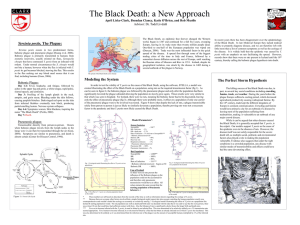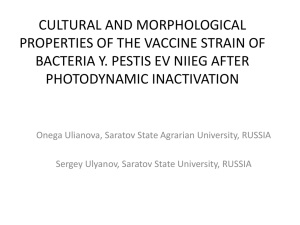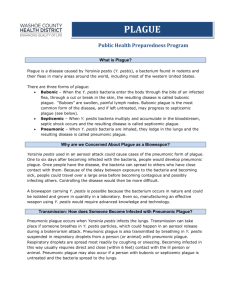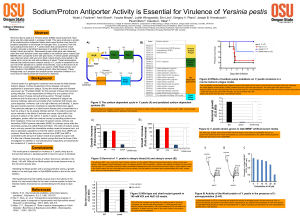Evolutionary approaches to study the natural history of Yersinia pestis
advertisement
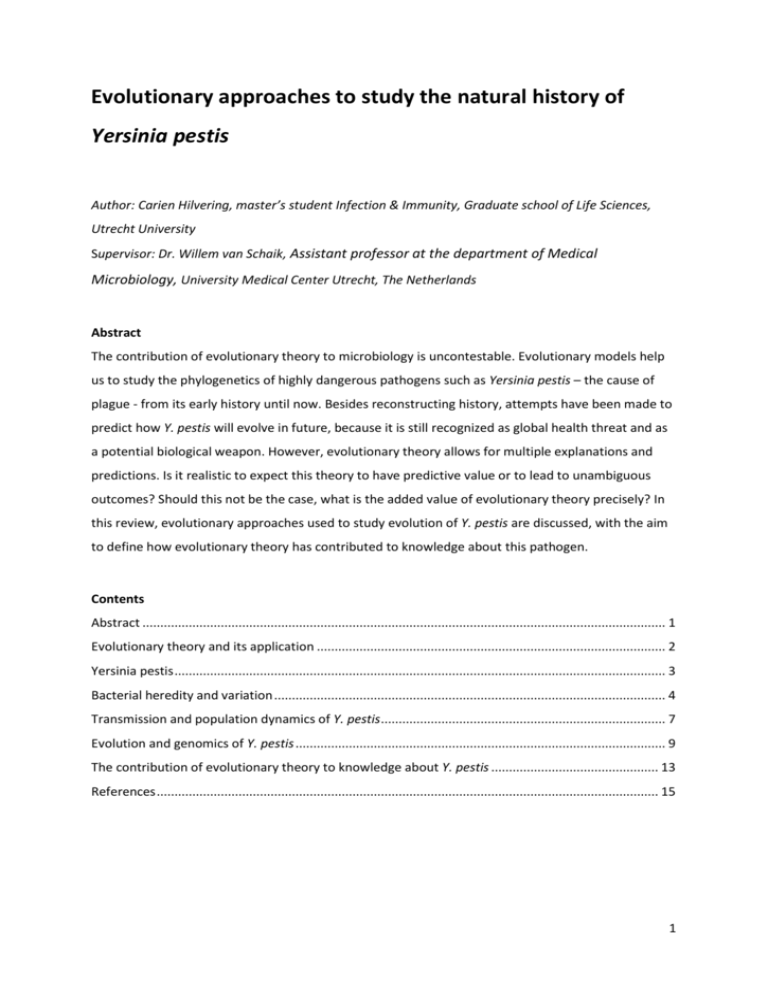
Evolutionary approaches to study the natural history of Yersinia pestis Author: Carien Hilvering, master’s student Infection & Immunity, Graduate school of Life Sciences, Utrecht University Supervisor: Dr. Willem van Schaik, Assistant professor at the department of Medical Microbiology, University Medical Center Utrecht, The Netherlands Abstract The contribution of evolutionary theory to microbiology is uncontestable. Evolutionary models help us to study the phylogenetics of highly dangerous pathogens such as Yersinia pestis – the cause of plague - from its early history until now. Besides reconstructing history, attempts have been made to predict how Y. pestis will evolve in future, because it is still recognized as global health threat and as a potential biological weapon. However, evolutionary theory allows for multiple explanations and predictions. Is it realistic to expect this theory to have predictive value or to lead to unambiguous outcomes? Should this not be the case, what is the added value of evolutionary theory precisely? In this review, evolutionary approaches used to study evolution of Y. pestis are discussed, with the aim to define how evolutionary theory has contributed to knowledge about this pathogen. Contents Abstract ................................................................................................................................................... 1 Evolutionary theory and its application .................................................................................................. 2 Yersinia pestis .......................................................................................................................................... 3 Bacterial heredity and variation .............................................................................................................. 4 Transmission and population dynamics of Y. pestis ................................................................................ 7 Evolution and genomics of Y. pestis ........................................................................................................ 9 The contribution of evolutionary theory to knowledge about Y. pestis ............................................... 13 References ............................................................................................................................................. 15 1 Evolutionary theory and its application Evolution is the change in inheritable traits of an entity or population over successive generations. Change is possible, because of the random mutations, recombinations and exchange occurring in genetic material, which leads to diversification of organisms. Furthermore, evolutionary pressure determines whether changes are successively passed on to later generations. Specifically, evolutionary pressure is anything that reduces the reproductive success of an entity. On the other hand, traits that improve reproductive success are selected by a process called natural selection. The theory of evolution is often simplified by the term ‘survival of the fittest’(1-4). Evolutionary theory provides an explanation for biological changes. Furthermore, it introduces concepts and processes that may influence biological changes. How can this be used to gain knowledge about microbial pathogens and what kind of questions can it answer? Darwin himself already tried to extract laws from his theory of evolution and base predictions on them(3). These attempts were not very satisfactory, because fitness of an organism depends on the environment in the broadest possible sense, which thwarts the ability to predict survival(3). The role of the environment in survival and fitness can be divided in direct effects and indirect effects (figure 1). Figure 1 Schematic overview of influences on the survival of organisms. Direct and indirect environmental changes influence the survival of organisms. Direct environmental changes affect survival independent of the organism’s characteristics. Indirect environmental changes affect the organism’s fitness, which thereby affects survival. Mutation influences fitness of an organism as well. Direct environmental effects are changes in the environment that influence the organism’s survival directly, which means that they are totally unconnected to the organism’s characteristics. In contrast, indirect environmental effects are environmental changes that influence the fitness of an organism, thereby indirectly affecting survival of the organism. For instance, a meteorite crash belongs to environmental changes that directly affect survival, because survival is dependent on fortune and not 2 on fitness (e.g. one of an identical twin may survive while the other may not)(3). Direct effects are mostly accidental and sudden environmental changes. Examples of environmental changes that indirectly affect survival are changes in temperature and availability of energy sources. In these cases, survival of the organism depends on its capacity to adapt to the changes. Indirect environmental changes are mostly slow and continuous changes. The influence of the environment implies that we can only predict survival of species when we are able to predict environmental changes(3). Besides the environment, mutations influence fitness of organisms as well. Stochasticity – randomness- in the occurrence of mutations and recombinations makes predictions of evolution even harder(3, 5). Additionally, the precise effect of the environment on mutations is not clear either. We know that environmental factors such as UV light and chemicals cause mutations in genetic material, but we are not able to predict where in the genome this will be and what the effect on fitness of organisms is. Whether the incapacity of evolutionary theory to be predictive is just due to a lack of data or inherent to the theory, is still ongoing(5). However, predictive value is not the only value that contributes to scientific knowledge. In this review we will investigate how evolutionary theory is used to obtain insights into the natural history of the bacterium Yersinia pestis, the cause of plague. Yersinia pestis Yersinia pestis is a zoonotic gram-negative bacterium, which belongs to the Enterobacteriaceae family. Y. pestis causes plague in humans and is fatal without antimicrobial treatment(6-8). Three types of plague are distinguished based on the infected tissue. In bubonic plague, lymph nodes are swollen due to infection and these swellings are called buboes. The second form of plague is septicemic plague, in which high numbers of bacteria are found in the bloodstream. Blood clotting during infection lead to the typical subcutaneous bleedings, which turn black and hence the alternative name for plague: ‘Black Death’(6, 7). The third tissue that can be infected with Y. pestis are the lungs during pneumonic plague. This form of plague can spread between humans without the need for animal vectors and is therefore highly dangerous concerning epidemic spread(6, 9). Y. pestis is thought to have caused three pandemics: The Plague of Justinian (541-750), Black Death (14-19th centuries) and the Third Plague Pandemic (19th and 20th centuries)(8-10). The pandemic outbreak of Black Death is a good example of a rapid emerging epidemic and is thought to be responsible for the observed genetic divergence that has occurred in Y. pestis around that time(8). The Black Death started in Northeastern Europe in 1347 and spread via the Mediterranean countries 3 to Northwestern Europe(11). In a period of only five years, 30-50% of the European population was perished as a result of plague(11). The total number of victims caused by Y. pestis is estimated around 160 million(12). Currently, 1000-3000 cases of plague are reported per year worldwide(13). Bacterial heredity and variation Four systems of inheritance are thought to influence the evolution of biological organisms(2): genetic inheritance, epigenetic inheritance, a behavioral system of inheritance and a symbolic one. In this review we will focus mainly on genetic inheritance, because genome-wide information on epigenetic evolution of Yersinia pestis is not available and behavioral and symbolic inheritance do not apply to bacteria. The field of population genetics studies inheritable traits that are passed on by genetic material by determining the frequency by which genetic patterns (alleles, genes, mobile elements) occur and how these change over time(1, 14). This field of research has been boosted by the development of high-throughput sequencing techniques since the mid-1990s. The possibility to sequence whole genomes together with the relatively quick adaptive capacity of bacteria has given us much insight in evolutionary processes at the genetic level. Bacteria reproduce asexually by dividing the mother cell into two daughter cells in a process called binary fission. This leads to a clonal expansion of bacterial populations, in which chromosomes of daughter cells are identical to the initial clone(1, 4). Diversification of traits is established by de novo mutations in chromosomal DNA, which are passed on ‘vertically’ to descendants of the cell that acquired the mutations (box 1 SNPs and substitutions). This acquisition of random alterations in genetic material that is passed on to next generations is called genetic drift(1, 4). Eventually, genetic drift results in the emergence of new lineages and this can be depicted in a phylogenetic tree (box 2 a primer on phylogenetic trees). The tree structure enables us to infer how closely related species are and define the most recent common ancestor (MRCA) that is shared by multiple species. Furthermore, estimations about the moment in history when a bifurcation took place can be made, based on mutations rates of bacteria(1, 4). However, genetic drift is not the only process that alters genetic information in bacteria. Gene flow is the ‘horizontal’ transmission of chromosomal DNA between lineages of the same species, but also between distinct species(1). Gene flow takes place in bacteria as well by a process called horizontal gene transfer (HGT). During HGT, DNA is exchanged by parasexual mechanisms called conjugation, transformation and transduction(1). Horizontal exchange is likely to happen more often in the same or closely related species, since the exchange of chromosomal DNA is mostly dependent on 4 homologous recombination. This ability of horizontal exchange has consequences for genetic diversity, because it spreads mutations independently of lineages and can either increase or reduce diversity(4). Furthermore, HGT affects clonality of bacterial populations, because it enables convergence of separate lineages. The occurrence of homology due to convergent evolution is called homoplasy(14). Consequently, the structure of a tree may not suffice when depicting population genetics and this has resulted in the use of network or mosaic schemes of evolution(4). Box 1: SNPs and substitutions Single nucleotide polymorphisms (SNPs) are places in the genome where organisms differ in one nucleotide change(10, 15, 16). SNPs can be identified by comparing the sequences of different genomes. The number of SNPs is influenced by the mutation rate. Substitutions are changes in the genome inherited by virtually all individual descendants of a species(15). Therefore, knowledge about the genealogy of compared species is needed, to determine whether the observed SNPs are substitutions. The substitution rate reflects the mutation rate and this rate differs between species and over time(15). In genetics, non-synonymous mutations and synonymous mutations are distinguished. A synonymous mutation is a mutation in a protein-coding DNA sequence, which does not change the encoded amino-acid. On the contrary, a non-synonymous mutation changes the encoded amino-acid. One can imagine that genetic drift – the occurrence of random mutations- affects synonymous and non-synonymous mutations equally(14, 15). On the other hand, natural selection is suspected to have more influence on non-synonymous than synonymous mutations, because they have larger effect on the phenotype. The effect of non-synonymous mutations can be deleterious, but may also be strongly advantageous and therefore the ratio of non-synonymous mutations (dN) to synonymous mutations (dS) will be affected by natural selection. During ‘neutral evolution’, dN/dS =1. When non-synonymous mutations are advantageous dN/dS will be >1. When non-synonymous mutations are deleterious, dN/dS will be <1. This ratio is often used to determine the dominating evolutionary processes that take place in a gene or in small parts of the genome(14, 15). 5 Box 2: A primer on phylogenetic trees Phylogenetic trees are essentially graphic representations of the inferred evolutionary relationships between entities/characters (species, genomes, short sequences). The distance between two characters in a phylogenetic tree resembles the evolutionary distance between those two characters. The construction of the network or tree can be performed using different mathematical approaches and in order to depict an accurate phylogeny a suitable approach has to be followed(17). Two main approaches are distinguished: (1) a character-based approach or (2) a distance-based approach. In a distance based approach, the distance between characters are calculated pairwise (figure box 2). After this calculation, the tree is reconstructed with these distances and characters are ignored. In a character-based approach, the model of reconstruction makes use of the characters on themselves. Figure box 2 A distance matrix of five characters. The numbers in the blue boxes are the characters 1 to 5 and they are plotted against each other. The numbers in white boxes are the distances between the plotted characters. Evolutionary relationships can be inferred from differences between or within species, for instance in appearance (morphovars), biochemical or physiological features (biovars), antigenic properties (serovars)(10). However, the determination of the genetic distance between bacteria will provide the most accurate description of the evolutionary trajectory of a bacterial species and, consequently, modern phylogenetic trees are almost exclusively based on genetic information. To choose the proper approach for an accurate phylogenetic tree, one should know what drives the genetic variation in the organism: mutation or recombination. Namely, the level of genetic drift and gene flow has consequences for population dynamics(17). Diversity in fully clonal populations is pushed by genetic drift, while diversity in totally panmictic – where random mating occurs -populations exists due to recombination(17). Most bacterial populations are not completely clonal or panmictic and both mutation and recombination occur, or have occurred in the history of a species. The trees that are generally used in phylogenetics are trees based on optimality criterions. These optimality criterions make it possible to choose the best approach that fits a dataset depending on how the criteria are optimized. Examples of phylogenetic trees that make use of optimality criterions are maximum likelihood trees, maximum parsimony trees and minimum spanning trees(17). 6 (Box 2 continued) Maximum likelihood trees (ML trees) use probability as an optimality criterion. When calculating ML trees the probability of each tree that can be formed with a given dataset is calculated. The probability is based on evolutionary models and the outcome therefore depends on the model used(17). This brings along the assumption that maximum likelihood indeed reflects reality best. For instance, one can assume that each nucleotide substitution has the same probability to occur. Another probability model assumes that transversions (pyrimidine to a purine or vice versa) are less likely to occur than transitions (pyrimidine to pyrimidine, or purine to purine)(15). The construction of maximum parsimony trees (MP trees) is a character-based approach and uses the assumption that the simplest model is the most accurate model. This means that a tree with the least evolutionary changes to explain a dataset of characters is preferred(17). The construction of minimum spanning trees (MS trees) is a distance-based approach and uses the optimality criterion of minimum distance. The optimal tree has a minimal total distance of branches compared to other trees that explain the dataset(17). Highly clonal populations can be accurately depicted by MS trees on the condition that homoplasies are not frequent, as is the case in Y. pestis(8, 14, 18). However, a character-based approach such as maximum likelihood is favoured as well in these cases. Phylogenetic trees that show evolutionary interrelationships between Y. pestis strains are often based on single nucleotide polymorphisms (SNPs), because the genetic variation between different samples is little and unrefined genetic approaches for phylogenetic analyses do therefore not suffice(18). Transmission and population dynamics of Y. pestis Despite the important role of Y. pestis in human history, rodents and fleas are the primary hosts of Y. pestis during endemic or enzootic periods, but epidemic expansions can lead to infection of almost all mammals(9, 10). Transmission among mammals occurs via fleabites, respiratory droplets or physical contact(8, 9, 19). The enzootic cycle exists of transmission between fleas and maintenance hosts. These maintenance hosts are partially resistant and therefore enzootic populations show less mortality than epidemic populations(9). Sometimes, Y. pestis spreads from maintenance hosts to more susceptible hosts, called epizootic hosts. What exactly determines the shift from enzootic to epizootic transmission 7 cycles is not fully understood(20, 21). However, it is clear that humans are more prone to infection during high die-off numbers of rodents(20). This increased susceptibility could be due to increased exposure to infectious fleas and dead animals. Furthermore, the assembly of spatially distinct groups of hosts may also determine the shift from enzootic to epizootic transmission cycles. Fleas may serve as a connection between such groups and the importance of flea transmission dynamics in the population dynamics of Y. pestis became apparent recently(20). The proposed models show that flea characteristics that give rise to the turnover rate and strength of flea infection cycles strongly affect epizootic behavior of Y. pestis(20). When fleas ingest a blood meal from an infected host, bacteria enter their digestive tract. The digestive tract of a flea consists of a foregut and a midgut (figure 2). A valve in the foregut called proventriculus prevents regurgitation from blood from the midgut to the foregut. The midgut is one single structure that is responsible for bloodmeal storage, digestion and adsorption(19, 22). Half of the infected fleas clear a Y. pestis infection, because the bacteria do not adhere to the midgut epithelium and infection is therefore dependent on ingestion of high amounts of bacteria. When bacterial density is high enough, bacterial aggregates are formed that are too large to be excreted through feces. These aggregates grow until fleas are colonized with 105 to >106 bacteria after two weeks of infection(19, 22). Figure 2 Digestive tract of Xenopsylla cheopis. (a) The flea’s digestive tract filled with blood immediately after consuming blood (b) Dissection picture of the flea’s proventriculus (PV) (c) Dissection picture of the flea’s digestive tract consisting of the esophagus (E), proventriculus (PV) and midgut (MG). (d) Dissection picture of the flea’s digestive tract containing a biofim. Figures adapted from(19) and (23). 8 The formation of aggregates in the flea midgut is dependent on the Yersinia murine toxin (Ymt) gene, which encodes a phospholipase D (PLD) and is present on a Y. pestis specific plasmid called pMT(19, 22). The expression of Ymt is enhanced when temperature drops, which is the case when Y. pestis enters a flea from the mammalian host. Without PLD protein production, fleas clear a Y. pestis infection within one day from the flea midgut(19, 22). When the number of Y. pestis bacteria in the midgut rises, this may lead to biofilm formation on the flea’s proventriculus (figure 2d). This biofilm hinders function of the proventriculus - the prevention of regurgitation - and therefore increases the chances on bacterial transmission from the flea into new hosts(19). Biofilm formation depends on hmsHFRS genes in chromosomal DNA that produce polysaccharide extracellular matrix (ECM) (19, 24). This biofilm can block the ingestion route partially or completely and in both cases the flea will starve leading to an increase in feeding attempts, thereby enhancing transmission possibilities. Complete blockage of the digestive tract eventually leads to the flea’s death, but partial blockage does not lead to increased mortality and these partially blocked fleas can therefore infect many hosts throughout their lifetime(19). For a long time biofilm formation in fleas (‘blocked’ fleas) has been thought to be required for transmission into new hosts. However, the occurrence of early-phase transmission (≤ 4 days post infection) in unblocked fleas has been shown by Eisen et al. in 2006(25). The existence and relevance of early-phase transmission in (epidemic) spread of Y. pestis is not fully accepted in the field(21). However, evidence has accumulated in the past years that support the existence of early-phase transmission and some attempts have been made to investigate how it influences population dynamics of Y. pestis(20, 25-28). The possibility of early-phase transmission allows for the existence of a short-term reservoir (2-3 weeks) required to explain the fast rates of epidemic spread, which could not be explained by blocked flea transmission(20, 25, 29). Evolution and genomics of Y. pestis The Yersinia lineage diverged approximately 200 million years ago into a Yersinia enterocolitica and a Yersinia pseudotuberculosis lineage(30). Both carry functional variants of a low calcium response virulence plasmid (LCR), often called pCD1 or pYV (Yersinia virulence(30)). Y. pestis evolved 28.0001500 years ago from the enteropathogen Y. pseudotuberculosis, which causes mild food- and waterborne diseases of the gastrointestinal tract(8-10). This is in contract to the high virulence of Y. pestis, which causes fatal disease without antibiotic treatment and is transmissible via flea vectors. Furthermore, Y. pestis is not an enteropathogen, but makes use of a dermal portal of entry(13). 9 The chromosomes of both Y. pestis and Y. pseudotuberculosis are closely related. 75% of the chromosomal genes in Y. pestis show ≥97% homology to genes of Y. pseudotuberculosis(31). Only 32 chromosal genes and two plasmids (PCP1 and PMT1) have been introduced in Y. pestis since the divergence from Y. pseudotuberculosis(31). The introduced genes in Y. pestis encode for membrane proteins, esterases, lipoproteins and DNA-binding proteins(31). Whether the newly acquired chromosomal genes provide an explanation for the high virulence of Y. pestis is not clear yet. Furthermore, the newly acquired plasmids cannot fully account for high virulence, since the introduction of these plasmids in Y. pseudotuberculosis did not yield as high virulence as is seen in Y. pestis(31). The introduced plasmid PCP1 is responsible for tissue invasion and capsule formation, while pMT1 is responsible for flea infection(31). The source of these plasmids remains under discussion(16), but half of the DNA sequences of pMT1 show similarity to DNA sequences on a Salmonella enterica plasmid(9, 10, 16). Surprisingly, the plasmid (pYV) that encodes for a type III secretion system, which is capable of suppressing phagocytosis and other innate immune responses, is shared by both Y. pestis and Y. pseudotuberculosis and is therefore not able to explain the difference in virulence(31). On the contrary, 317 genes of Y. pseudotuberculosis are absent in Y. pestis and 147 genes have mutated into pseudogenes, suggesting that loss of genes may contribute to pathogenesis as well. The function of identified pseudogenes are largely known and they are found to be important in metabolism, cell-cell contact and pathogenesis(13, 31). For instance, some toxins are turned into pseudogenes, which may enable Y. pestis to use fleas as a vector(13). Furthermore, pathoadaptive mutations – mutations that increase virulence by the inactivation of a gene- may also account for the increased virulence(13). Besides introduction and loss of genes and plasmids, an increase in insertion (IS) elements and regions with a high GC-content is seen in Y. pestis(13, 31). The increased IS elements indicate that the genome of Y. pestis underwent more insertion events than Y. pseudotuberculosis. Genome rearrangements such as insertions and recombination events most likely account for the increase in GC regions. Comparison of three Y. pestis strains indicates that genomic rearrangement may be more important than acquisition of new genes, because many differences in rearrangement events can be distinguished between the three strains(13, 31). However, the exact contribution of genomic rearrangement to virulence has to be revealed by further research. Before DNA sequencing techniques were easily accessible, Y. pestis samples were characterized by their ability to reduce nitrate and ferment sugars(10). The biovars Orientalis, Medievalis, Antiqua and Pestoides were distinguished in this way(10) and the abbreviations ORI, MED, ANT and PE are still 10 used, respectively. However, genomics is now used to identify new strains and compare them to known strains. The genome of Y. pestis can be divided into a core-genome and an accessory genome, which both form the pan-genome of the bacterium(8). The core-genome is defined as the genomic DNA that is present in all Y. pestis strains, while the accessory genome is variably present in strains. The coregenome is 3.53 Mb in length and the pan-genome is 5.46 Mb in length, based on the genomes of 133 strains(8). Only 2298 single nucleotide polymorphisms (SNPs) have arisen in the core-genome since the emergence of Y. pestis, which makes it a highly monomorphic pathogen(8). Furthermore, almost all of the acquired SNPs have occurred only once, which makes the reconstruction of the phylogenetic tree reliable(8, 10). Additionally, the sequenced genomes have been aligned to a wellannotated genome to filter repetitive SNPs, which may have emerged due to recombination events(8, 10). Despite the monomorphic genetics of Y. pestis, multiple bursts of diversification called polytomies are present in the phylogenetic tree (figure 3)(8). Polytomies are nodes where more than two branches orginate from. These polytomies occur in an uneven pace along the branches, which implies that the substitution rate varies over time(8). These periods of high substitution rates could be explained by multiple diversifying events rapidly followed by natural selection and thereby fixation of mutations in a lineage. However, the observed ratio of non-synonymous mutations to synonymous mutations (dN/dS ) is nearly neutral. Furthermore, no signs of homoplasies have been observed(8). Therefore, it is now believed that high mutation rates are generated by high replication rates due to a shift from the endemic, sylvatic phase of the bacterium to an epidemic spread among variant host species(8). 11 Figure 3 Minimum spanning tree of 133 genomes, based on 2298 SNPs in the core-genome of Y. pestis. An Y. pseudotuberculosis is used as an out group and is depicted as the most recent common ancestor (MRCA). Five branches are recognized, numbered from 0 to 4. Colours distinguish populations within branches. Biovars are abbreviated as follows: Medievalis (MED), Orientalis (ORI), Antiqua (ANT), Pestoides (PE), Intermediate strains between ORI and ANT (IN). Branch lengths are proportional to the natural logarithm of the amount of SNPs between nodes, or between nodes and endpoints. Figure reproduced from Cui et al. (8). 12 The contribution of evolutionary theory to knowledge about Y. pestis Despite its inability to predict evolution of microbes, evolutionary theory still contributes to knowledge about microbial evolution, because the value of a scientific theory not only depends on its predictive power, but also on its explanatory power(3). In this part, we will touch on the explanatory power of evolutionary theory in understanding the evolution of Y. pestis. Cui et al. recently published a comprehensive and detailed paper on the phylogenetics of Y. pestis and they have used evolutionary theory as a tool to search for new data(8). I will review their approach, claims and hypotheses to demonstrate the use of evolutionary theory. First of all, the monomorphic nature of Y. pestis is affirmed by the comparison of 133 genomes that are sampled at different locations and time points. The sampled bacteria are obtained from humans, a variety of rodent genera, other non-primate mammals and human fleas. The isolates were sampled in China, the former Soviet Union, Madagascar, Mongolia and Myanmar. The search for geographical and host diversity in sampling is based on the understanding that this way of sampling will probably lead to large evolutionary distances and these are needed for an accurate phylogenetic analysis. Secondly, the usage of Y. pseudotuberculosis as an outgroup for the phylogenetic analysis in this study and earlier studies(31) revealed that Y. pestis diverged from Y.pseudotuberculosis. The concept of Darwin’s tree of life and the existence of a common ancestor, makes the comparison of these genomes understandable. Furthermore, the use of a Maximum Likelihood approach to reconstruct Y. pestis phylogeny is based on appropriate evolutionary models as well. Only 2298 SNPs were present in the core-genome of 133 Y. pestis genomes(8). This was not due to convergent evolution, because there were no or little traces of recombination events. Furthermore, the genetic variation was mainly caused by neutral evolution, because dN/dS was 0.91. By using evolutionary theory as a tool and deduce from it the effect of natural selection on dN/dS ratios, knowledge is yielded about the cause of genetic variation in Y. pestis, which was concluded to be mainly caused by genetic drift. The results show correlation of a polytomy (‘starburst genealogy’) with the spread of plague in the Middle Ages. Furthermore, they show that mutations arise at uneven pace during the evolution of Y. pestis. Evolutionary approaches imply a few possibilities to explain these facts, namely: (1) the existence of a mutator strain, (2) rapid fixation of favourable SNPs due to diversifying selection or (3) simply the effect of increased replication due to epidemic spread. Cui et al. investigated these possibilities and they were able to refute the first two options. In earlier studies, they already concluded that plague had spread from China or somewhere near China(10). This also hinted towards the demographic changes in history of the bacterium. They compared ancient Chinese trade 13 routes with the sampling locations of the study’s Chinese samples and indeed, there is a correlation between the trade routes and the sampling locations. Furthermore, samples of the deepest branching lineages were only found on the Qinghai-Tibet plateau and this may be the origin of Y. pestis spread. The samples obtained in this region also show the highest diversion, which can also suggest that it is the original source of spread(8). This made them suggest that the changes between endemic and epidemic periods have caused the changes in clock rate variation(8). Figure 4 The correlation of Y. pestis samples and ancient trade routes (grey lines). The circle depicts the Qinghai-Tibet Plateau. The colours and figures of samples are shown in the legend (supplemental information can be found in figure 3). Figure reproduced from Cui et al (8). Finally, reports showed that Black Death has most likely been caused by Y. pestis, because antigens and DNA of Y. pestis has been found in skeletons of Black Death patients(11, 32, 33). Additionally, 14 reconstructions of Y. pestis genomes have been made with samples of skeletons buried in Londen and Germany, shortly after Black Death was reported to have reached Europe(11, 34). Furthermore, recent findings on skeletons between the 5th and 7th centuries, support the hypothesis that the Justinian Pandemic was also caused by plague(35-37). The search for data that can either confirm or refute the hypotheses based on evolutionary models is a perfect example of the value of evolutionary theory in gaining knowledge on microbial evolution. This shows that evolutionary theory is used as heuristic method to formulate new research questions. Furthermore, the enormous explanatory power of evolutionary theory help us to understand natural processes occurring during the evolution of microbes. The incapacity of evolutionary theory to have predictive value –at this moment – does not set back the value of evolutionary theory. To conclude with a phrase of Michael Scriven (1959)(3): ‘Satisfactory explanation of the past is possible even when prediction of the future is impossible.’ References 1. Gogarten JP, Townsend JP. Horizontal gene transfer, genome innovation and evolution. Nat Rev Microbiol. 2005 Sep;3(9):679-87. 2. Pigliucci M. An extended synthesis for evolutionary biology. Annals of the New York Academy of Sciences. 2009;1168:218-28. 3. Scriven M. Explanation and prediction in evolutionary theory. Science. 1959;130(3374):477-82. 4. Spratt BG, Maiden MC. Bacterial population genetics, evolution and epidemiology. Philosophical Transactions of the Royal Society of London.Series B: Biological Sciences. 1999;354(1384):701-10. 5. Gerrish PJ, Sniegowski PD. Real time forecasting of near-future evolution. Journal of the Royal Society Interface. 2012;9(74):2268-78. 6. Prentice MB, Rahalison L. Plague. The Lancet. 2007 4/7–13;369(9568):1196-207. 7. Raoult D, Mouffok N, Bitam I, Piarroux R, Drancourt M. Plague: History and contemporary analysis. J Infect. 2013 1;66(1):18-26. 8. Cui Y. Historical variations in mutation rate in an epidemic pathogen, yersinia pestis. Proc Natl Acad Sci U S A. 2013;110(2):577-82. 9. Gage KL. Natural history of plague: Perspectives from more than a century of research. Annu Rev Entomol. 2005;50:505-28. 15 10. Morelli G. Yersinia pestis genome sequencing identifies patterns of global phylogenetic diversity. Nat Genet. 2010;42(12):1140-3. 11. Bos KI, Schuenemann VJ, Golding GB, Burbano HA, Waglechner N, Coombes BK, et al. A draft genome of yersinia pestis from victims of the black death. Nature. 2011;478(7370):506-10. 12. Anker M, Schaaf D. WHO report on global surveillance of epidemic-prone infectious diseases. Geneva: World Health Organization; 2000. 13. Baquero F, Nombela C, Cassell GH, Gutierrez-Fuentes J. Evolutionary biology of bacterial and fungal pathogens. ASM Press Washington, DC, USA; 2008. 14. Achtman M. Evolution, population structure, and phylogeography of genetically monomorphic bacterial pathogens. Annu Rev Microbiol. 2008;62:53-70. 15. Lanfear R, Welch JJ, Bromham L. Watching the clock: Studying variation in rates of molecular evolution between species. Trends in Ecology & Evolution. 2010 9;25(9):495-503. 16. Prentice MB, James KD, Parkhill J, Baker SG, Stevens K, Simmonds MN, et al. Yersinia pestis pFra shows biovar-specific differences and recent common ancestry with a salmonella enterica serovar typhi plasmid. J Bacteriol. 2001 Apr;183(8):2586-94. 17. Hall BG. Phylogenetic trees made easy: A how-to manual. Sinauer Associates Sunderland; 2004. 18. Achtman M. Insights from genomic comparisons of genetically monomorphic bacterial pathogens. Philosophical transactions - Royal Society.Biological sciences. 2012;367(1590):860-7. 19. Chouikha I. Yersinia-flea interactions and the evolution of the arthropod-borne transmission route of plague. Curr Opin Microbiol. 2012;15(3):239-46. 20. Buhnerkempe MG, Eisen RJ, Goodell B, Gage KL, Antolin MF, Webb CT. Transmission shifts underlie variability in population responses to yersinia pestis infection. PLoS One. 2011;6(7):e22498. 21. Wimsatt J, Biggins DE. A review of plague persistence with special emphasis on fleas. J.Vector Borne Dis. 2009;46:85-99. 22. Hinnebusch BJ, Rudolph AE, Cherepanov P, Dixon JE, Schwan TG, Forsberg A. Role of yersinia murine toxin in survival of yersinia pestis in the midgut of the flea vector. Science. 2002 Apr 26;296(5568):733-5. 23. Hinnebusch BJ, Erickson DL. Yersinia pestis biofilm in the flea vector and its role in the transmission of plague [Internet]; 2008 [cited 24 January 2014]. 24. Hinnebusch BJ, Perry RD, Schwan TG. Role of the yersinia pestis hemin storage (hms) locus in the transmission of plague by fleas. Science. 1996 Jul 19;273(5273):367-70. 25. Eisen RJ, Bearden SW, Wilder AP, Montenieri JA, Antolin MF, Gage KL. Early-phase transmission of yersinia pestis by unblocked fleas as a mechanism explaining rapidly spreading plague epizootics. Proceedings of the National Academy of Sciences. 2006;103(42):15380-5. 16 26. Vetter SM, Eisen RJ, Schotthoefer AM, Montenieri JA, Holmes JL, Bobrov AG, et al. Biofilm formation is not required for early-phase transmission of yersinia pestis. Microbiology. 2010;156(7):2216-25. 27. Schotthoefer AM, Bearden SW, Vetter SM, Holmes J, Montenieri JA, Graham CB, et al. Effects of temperature on early-phase transmission of yersina pestis by the flea, xenopsylla cheopis. J Med Entomol. 2011;48(2):411-7. 28. Eisen RJ, Wilder AP, Bearden SW, Montenieri JA, Gage KL. Early-phase transmission of yersinia pestis by unblocked xenopsylla cheopis (siphonaptera: Pulicidae) is as efficient as transmission by blocked fleas. J Med Entomol. 2007;44(4):678-82. 29. Webb CT, Brooks CP, Gage KL, Antolin MF. Classic flea-borne transmission does not drive plague epizootics in prairie dogs. Proc Natl Acad Sci U S A. 2006 Apr 18;103(16):6236-41. 30. Bearden SW, Brubaker RR. Recent findings regarding maintenance of enzootic variants of yersinia pestis in sylvatic reservoirs and their significance in the evolution of epidemic plague. Vector-Borne and Zoonotic Diseases. 2010;10(1):85-92. 31. Chain, P S G Carniel, E Larimer, F W Lamerdin, J Stoutland, P O Regala, W M Georgescu, A M Vergez, L M Land, M L Motin, V L Brubaker, R R Fowler, J Hinnebusch, J Marceau, M Medigue, C Simonet, M Chenal Francisque, V Souza, B Dacheux, D Elliott, J M Derbise, A Hauser,L J Garcia, E. Insights into the evolution of yersinia pestis through whole-genome comparison with yersinia pseudotuberculosis. Proc Natl Acad Sci U S A. 2004;101(38):13826-31. 32. Signoli M, Fozzati L, Aboudharam G, Raoult D, Drancourt M. High throughput, multiplexed pathogen detection authenticates plague waves in medieval venice, italy. PLoS One. 2011;6(3):e16735. 33. Haensch S, Bianucci R, Signoli M, Rajerison M, Schultz M, Kacki S, et al. Distinct clones of yersinia pestis caused the black death. PLoS pathogens. 2010;6(10):e1001134. 34. Wiechmann I, Harbeck M, Grupe G. Yersinia pestis DNA sequences in late medieval skeletal finds, bavaria. Emerging Infectious Diseases. 2010;16(11):1806-7. 35. Wiechmann I, Grupe G. Detection of yersinia pestis DNA in two early medieval skeletal finds from aschheim (upper bavaria, 6th century A.D.). Am J Phys Anthropol. 2005;126(1):48-55. 36. Drancourt M, Signoli M, La VD, Bizot B, Roux V, Tzortzis S, et al. Yersinia pestis orientalis in remains of ancient plague patients. Emerging Infectious Diseases. 2007;13(2):332-3. 37. Harbeck M, Seifert L, Hänsch S, Wagner DM, Birdsell D, Parise KL, et al. Yersinia pestis DNA from skeletal remains from the 6th century AD reveals insights into justinianic plague. PLoS Pathogens. 2013;9(5). 17
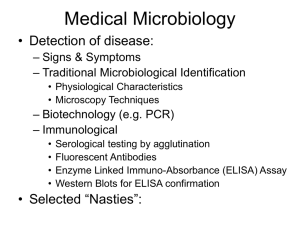
![[Presentation by Sara Morgans].](http://s2.studylib.net/store/data/005578977_1-95120715b429730785aca2fdba9a2208-300x300.png)
